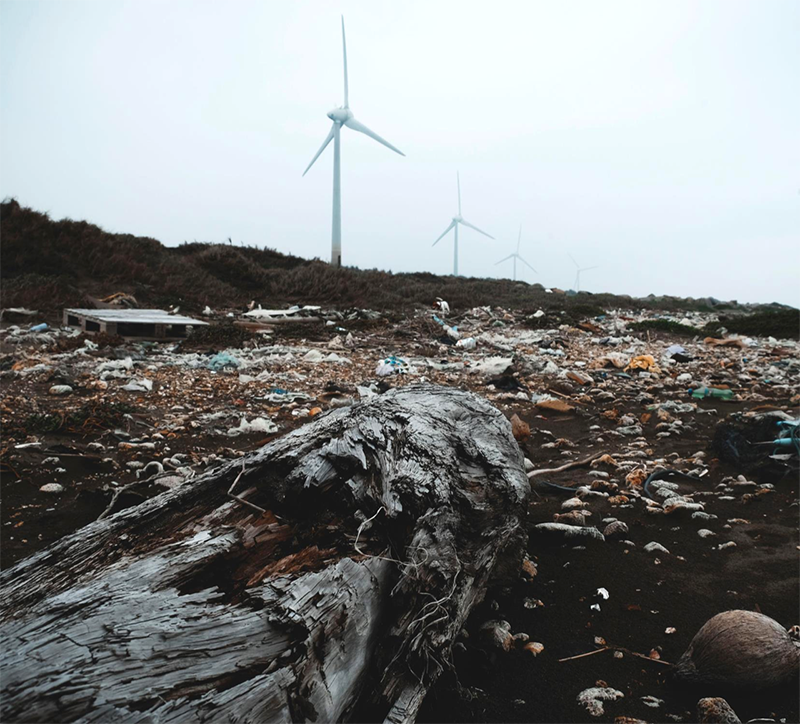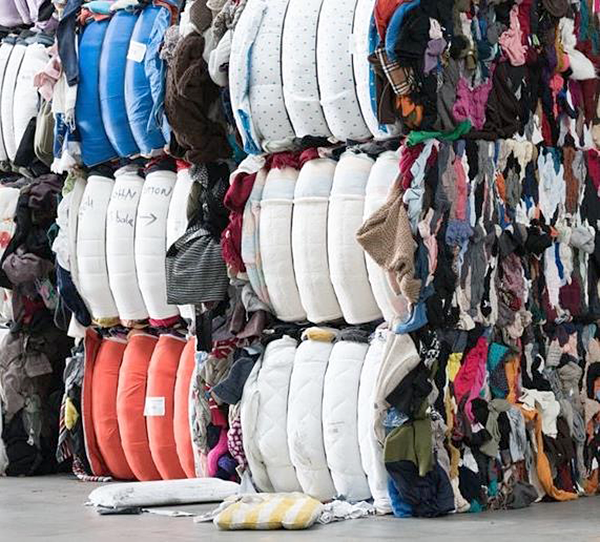In a three-part article starting in the Autumn 2022 issue of Canadian Quilter, Bridget O’Flaherty will be sharing her knowledge and experience regarding sustainability, to help quilters ensure we are doing all we can to protect the environment. Traditionally, quilting has not been a wasteful practice. You may already be a sustainable quilter in many ways, and as Bridget believes, every action matters, even the smallest ones. Strengthening our understanding of how individual activities have a cumulative impact, globally, empowers us to imagine new ways to bring sustainability into our quilting practice.
What is sustainability and why should quilters care?
Quilters have been known to be frugal with their fabrics, often reusing materials from clothing or food sacks, using all the smallest bits in their quilts, mostly using cotton, and making beautiful works that become heirlooms (we hope). We are harmless crafters who are just looking for joy in being creative, so what’s the fuss? This is all true, but our industry is huge; it is an estimated $4-billion industry in the US alone. Quilting is connected to the textile industry, because of the production process of materials and the way marketing promotes consumerism. Three top sustainability issues are textile waste, water use, and carbon emissions.
Textile Waste
What happens after the textile product is no longer useful to the person who bought it? The average Canadian puts 80 lbs of textile waste into landfills annually, that’s a lot of t-shirts or quilt fabric! Not to mention that when these textiles get shipped to other countries, they end up in what are essentially dumping grounds under the guise of aide.
Water Use
Did you know that it takes 2700 litres of water to manufacture a metre of fabric? That’s equivalent to drinking water for one person over 2.5 years. That water does return to the water cycle, but it often takes with it the chemicals used in the process, which impacts plants, animals, and humans that are exposed to them. Textiles are primarily produced and manufactured in regions where communities already have inequities with accessing clean drinking water.


Carbon Emissions
Did you know that the textile industry is the fifth largest contributor to greenhouse gases? Textiles contribute around 10% of global greenhouse gas emissions because of their long supply chains and energy-intensive production; that’s more than international flights and marine shipping combined.
Evidence of climate change is a hot topic and, in the news, regularly. Globally, we are seeing changes in the environment that are impacting not only people directly through health and comfort, but also indirectly through water quality and quantity, soil degradation, sea ice loss, extreme temperatures, forest fires, landslides, weather events, and so much more. These changes are impacting our daily lives and are driven by increased temperatures on the planet.
There’s a lot of eco-anxiety out there. Feelings of hopelessness and fear of doom for the planet are commonplace, and I know quilters are feeling this too. It’s becoming obvious to me that we need more education, more conversations, and more understanding of what our hobbies are contributing when it comes to climate change. We need to take a micro look within our own practices as well as the bigger picture of the industry.
It is my hope that by sharing some of the scary statistics, highlighting the issues, and showing how people are making a difference, you might be able to make some small changes in your own quilting. After all, small actions make ripples, which lead to waves of change.
Small actions make ripples, which lead to waves of change.
A Deeper Dive into Sustainability and Textiles
The modern idea of sustainability stems from a concept from the world’s first Earth Summit in Rio in 1992, with the first global discussions around sustainable development. Today, there is still no universally agreed-upon definition of sustainable development, however, three pillars – environmental, societal, and economic impacts – are the foundation. We can’t have sustainability if we don’t consider all three. The general idea behind sustainability is that resources we use meet the needs of the present, but should not compromise the ability of future generations to meet their needs.
So where does quilting fit into all of this?
Climate change is obviously no longer a future problem. If we look back, we can see the road that led us here. Textiles have been part of human culture for thousands of years. We have been producing and making beautiful things for centuries. However, the textile industry changed dramatically during the Industrial Revolution. When we look at quilting/textiles, the primary sustainability issues stem from material (over)production – which uses a lot of water and energy, and include transportation and packaging plastics, which are all linked to fossil fuel use. Even the dyes used in textiles are derived from fossil fuels. The earliest commercial synthetic dyes, introduced in 1856 by a chemist who discovered synthetic mauve and red not long after, came from coal tar. These discoveries were exciting, mass production became possible, factory-driven production took off, and the textile world exploded.
The carbon footprint of textiles is long and complex. When we look at textiles, we look through all of the sustainability pillars to understand the overall impacts. The carbon footprint of textiles is based on the “embodied energy” or life cycle of the fabric, which includes all the energy used at each step of the process that is needed to create that fabric. But the environmental impact is not the only measure. The social impacts are huge, so much of textile production happens in developing nations. Dehumanizing labour and abysmal living conditions are common, and the balance of economic equity is very problematic.
This all sounds so overwhelming, I know. Climate anxiety is a real thing! But this is where quilters shine as far as I am concerned. We are so good at re-use: T-shirt quilts, memory quilts, swatch swapping, and fabric donations are an inherent part of a quilter’s life. There is always more that we can do, but I want to be clear, it’s not all or nothing, small actions matter. I’m not suggesting you stop buying your favourite fabric or patterns. I’m not saying get rid of all of your tools or supplies that are not made with sustainability in mind. We still live in this big old world, we still have to function and, after all, we do make beautiful things. But there is more that we can do when we have awareness of the impacts our decisions make.
Sustainability starts with the individual. Our daily decisions have lasting impacts in our community, and then trickle out to have greater impacts globally. We have an opportunity to look at our own habits and practices and choose to change. Next, a few examples of things you can start to do.
This is where quilters shine as far as I am concerned. We are so good at re-use.
Eleven things quilters can do to help make the industry more sustainable
1. Stop using spray adhesives for basting. There are harmful chemicals used in many spray adhesives, which can be bad for your health and impact greenhouse gases, and those same chemicals can reduce the longevity of your quilt. Switch to pin or stitch basting.
2. Mindful Quilting. Slow stitching movements are on the rise with hand work like embroidery, mending, Shibori and Shasiko stitching, for example. When we slow down and connect with the work, we are nurturing ourselves. These can be very important moments for our own well-being. Try making a project or two by hand to see if you like the slower process.
3. Make a donation quilt. Our community is one of the most important places to start with sustainability. How we connect with our past (veterans, cancer survivors, residential school survivors; for example), also impacts future generations and tells
stories that need to be remembered. This is particularly important work for the social fabric of sustainability. Try using materials you already have in your stash, or upcycle clothing in your projects for a meaningful memory quilt.
4. Use what you have before you buy more. Our society and quilt culture is commodified, there’s no getting around that. The next line of interesting and beautiful fabrics is just around the corner. But if we commit to doing even just one project a year that uses no new materials, we can reduce the consumer impact.
5Save materials that are unusual. Have a look at things you already have in new ways, you can use waste like plastics or paper, clothing, or linens – challenge yourself in your creative endeavours.
6. Upcycle fabrics (sheets, clothing, tablecloths). Shop at thrift stores, auctions, or yard sales for interesting materials to use in your projects.
7. Learn about certifications and labels. There are third party certifications that producers can use to show us the accountable actions they are taking to make their products sustainable. Look for them and ask for them when buying supplies.
8. Buy organic for one project. You don’t have to change to only buying organic, build your organic stash one project at a time.
9. Raise awareness. Create an art quilt of issues you care about like endangered species, social issues, habitat loss, etc. Sharing these stories helps spread awareness, you never know who you will impact with your art.
10. Read about sustainable issues. Knowledge is power. Have a look into the textile industry, listen to podcasts, read blogs, follow activists and artist that are sharing the message on social media.
11. Support companies and artists. Buy materials or even take classes from companies and artists that are leading the way with sustainability.
I hope you are as excited about the change that can come from small actions as I am. I’ll be back with some more sustainability insights. In the next article we will look at “The Cotton Trail,” where I’ll show you some of the environmental, social, and economic impacts of the cotton industry; we will learn about sustainable certifications and labeling, and some of the companies that are using them; and we will get a better understanding of “greenwashing”.
 Bridget O’Flaherty is a Canadian free-motion embroiderer, quilter and textile artist, teacher, speaker and podcaster with a decade of experience in the sustainable building industry. Known as The Sustainable Quilter, she shares her passion for the natural environment in her art and online community.
Bridget O’Flaherty is a Canadian free-motion embroiderer, quilter and textile artist, teacher, speaker and podcaster with a decade of experience in the sustainable building industry. Known as The Sustainable Quilter, she shares her passion for the natural environment in her art and online community.
bridgetoflaherty.com
bridgetoflaherty.com/threads-of-sustainability-podcast/
@thesustainablequilter


